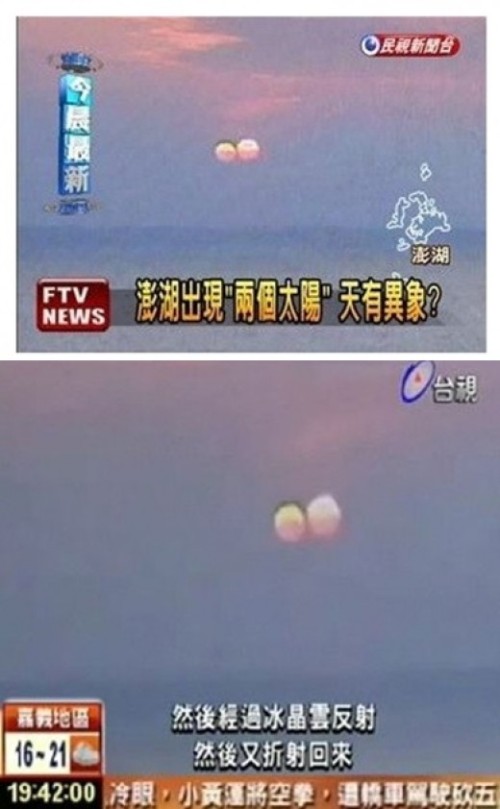The appearance of “two suns” in the Taiwanese sky has made people wonder whether the second one is an exploded Betelgeuse, the second biggest star in the constellation Orion.
News.com.au reported in January that Betelgeuse was losing mass in its center and would explode when it ran out, creating a second sun in the night sky, citing Dr. Brad Carter, senior lecturer of Physics at the University of Southern Queensland.
Space.com reported, however, that the second sun was not Betelgeuse, but just “an effect of optical refraction.”
According to the report, the mirage was caused by particles of ice in the sky refracting light, resulting in a small round, sparking dot next to the sun.
“I doubt it’s been computer modeled,” Jim Kaler, a University of Illinois astronomer, said in the report, but it is “pretty darn rare.”
Flemish astronomer Marcel Minnaert wrote in “Light and Color in the Outdoors” that “the case of a mock sun three degrees and 25 arc-seconds to the left of the nearly set sun sounds incredible but has been recorded photographically.”
Lee Woo-young (wylee@heraldcorp.com)
<한글 요약>
대만 상공에 나타난 쌍둥이 태양
대만 하늘에 뜬 ‘쌍둥이 태양’에 관심이 집중되면서 ‘쌍둥이 태양이’ 지난 1월 ‘두번째 태양’인지에 대한 궁금증이 커지고 있다.
지난 1월 news.com.au는 퀸즈랜드 대학 물리학 교수의 말을 인용하며 오리온자리의 베텔게우스가 수명을 다하면서 2012년쯤 지구 근처까지 와서 폭발할 것이고 이것은 두번째 태양이 보이는 효과를 나타낼 것이다 라는 보도를 한 적이 있었다.
그러나 스페이스닷컴의 보도에 따르면 ‘쌍둥이 태양’은 단지 대기중이나 구름에 있는 미세 얼음조각들이 빛을 굴절시켜 일어나는 현상으로 신기루에 가깝다고 한다. 이는 무리해(mock sun) 현상 또는 환일현상(Sundog)로 불리면서 컴퓨터로 조작된 것이 아니라고 한다.
실제 태양 바로 옆에 나타나는 현상은 매우 드문 일이나 과거 무리해 현상이 나타난 증거가 사진으로 남아 있다고 전문가들은 말했다.






